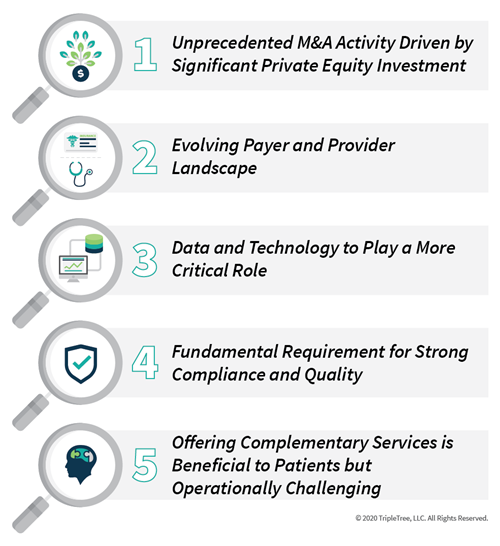Healthcare Services Insights
Five Observations from the Autism Investor Summit
March 6, 2020
As we transitioned into February, the healthcare market circled around the 2nd Annual Autism Investor Summit which brought together industry stakeholders within the autism industry to discuss some of today’s most pressing themes. Participants ranged from senior executives of private equity-backed autism platforms, entrepreneurial clinician owners, technology leaders, and active investors, among others. TripleTree had the pleasure of leading a panel on Successful M&A Transactions in Autism, joined by a number industry leaders. Overall, there were many interesting topics discussed during the conference, but we came away with the following key observations:

Observation 1: Unprecedented M&A Activity Driven by Significant Private Equity Investment
Over the past few years, the private equity market has shown an increased interest in the autism market. Attendees cited several favorable investment tailwinds, including a higher autism incidence rate, longer waitlists, an enhanced reimbursement environment, and a large and historically fragmented market. Panel speakers and attendees noted the heightened M&A activity and strong valuations that are pushing the market as private equity firms look to grow and scale autism platforms. However, there is no ‘one-size fits all’ in how valuations are derived. Pro-forma adjustments and specific business model attributes have a significantly varied effect on valuations, as do the infrastructure investments that have been made into the target company. Buyers are willing to give credit for adjustments and future growth when they are supported by a track record of execution and a sustainable model going forward.
Observation 2: Evolving Payer and Provider Landscape
One of the more robust sessions during the Summit focused on the evolving payer and provider relationship in autism. No two children on the spectrum are the same and there is high variability in treatment from market to market (e.g., documentation, hours required, clinical supervisions, and parental involvement), leaving payers in need for enhanced measurability and benchmarking as they mature in their own understanding of the sector. Providers that are best able to show strong clinical evidence will be favorably positioned for stronger payer relationships with potentially higher reimbursement. Furthermore, providers are keen on driving this conversation forward so payers do not broadly reduce rates across the autism market, irrespective of the provider.
Observation 3: Data and Technology to Play a More Critical Role
On a related note, the variability in business models, training, development, philosophies and implementation, all compound to create an existing data and technology gap. The infrastructure used several years ago to effectively manage 50 separate caseloads worked well, however, as the industry has evolved and demand for ABA services has ballooned, the provider is now left in dire need for greater efficiencies and enhanced technology solutions. Access to accurate and individualized data driven by improvements in technology is paramount as payers continue to look for actionable insights and outcomes measurement. As such, companies that can unlock technology to effectively track, standardize, and report clinical data will be positioned favorably.
Observation 4: Fundamental Requirement for Strong Compliance and Quality
Another theme that we heard echoed throughout the Summit was the persistent need for a “rock-solid” compliance and quality measurement reporting process that can accurately report and support clinical outcomes. When autism platforms evaluate the viability of going to market, a clean compliance record supported by a strong audit, review, and oversight track record is paramount for a successful transaction. In today’s landscape, buyers do not have any leeway when it comes to historical compliance around patient care, utilization, and billing.
Observation 5: Offering Complementary Services is Beneficial to Patients but Operationally Challenging
Finally, throughout the Summit, attendees and panelists talked about the diversification of services to create a “one-stop-shop” beyond ABA for complementary development needs such as speech, occupational, and physical therapies. Offering such services under one roof can be beneficial to patients and families, increasing convenience, utilization, and access to care. However, providers often underestimate the difficulty of integrating these services with ABA therapy. Clinicians and organizations need to recognize that these services, while complementary, are delivered by different clinicians, who often have their own cultures and clinical philosophies, and require their own set of operational focus areas (e.g. billing, compliance, staffing, etc.) That said, there is no “right” services solution set as ABA, speech, occupational, and physical therapy offerings are all addressing the important needs of the autism community.
As we have advised our clients on M&A transactions over the past few years in the autism arena, we have witnessed the importance of these observations and the changes that are rapidly advancing the autism industry.
Did you attend the Autism Investor Summit? Let us know what you thought in the comments below.




